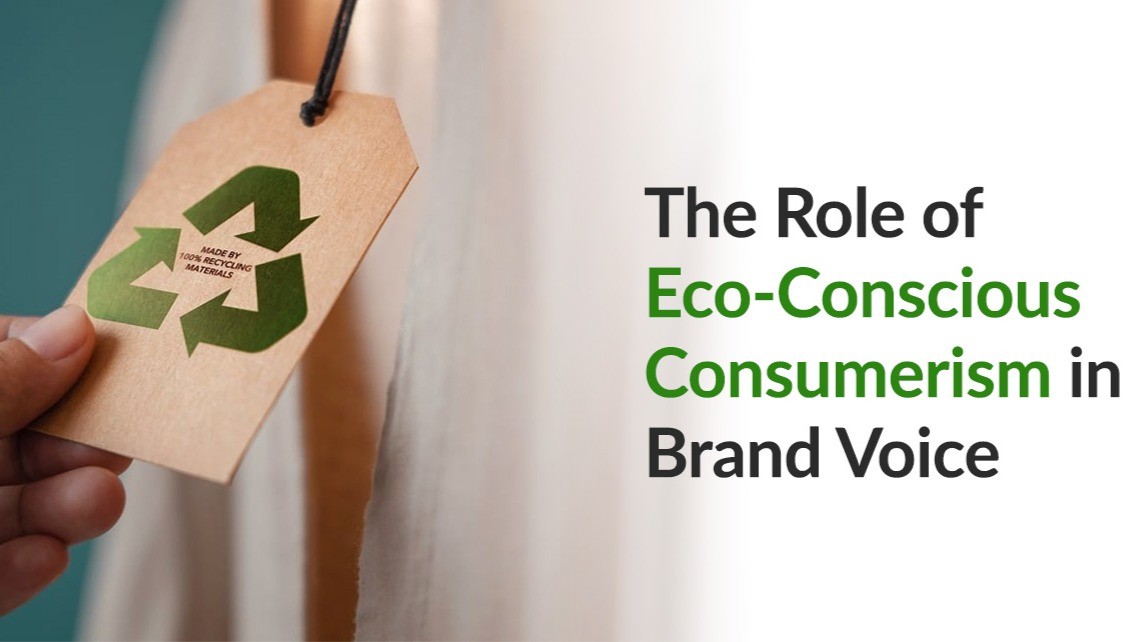In today’s world, it’s not just about what we buy, but how our purchases align with our values. Increasingly, consumers are seeking products and services that reflect their growing concern for the environment. This shift in consumer behavior, known as eco-conscious consumerism, has dramatically influenced the way companies communicate. Brand voice—the tone, messaging, and personality a company projects—has evolved in response to this growing demand for sustainability. In this blog, we’ll explore how eco-conscious consumerism is shaping brand voice and why it matters to both consumers and businesses alike.
What is Eco-Conscious Consumerism?
Eco-conscious consumerism is the practice of making purchasing decisions based on a product’s environmental and ethical impact. It’s about more than just being environmentally friendly—it encompasses a holistic approach to sustainability that includes ethical sourcing, waste reduction, fair labor practices, and more. From choosing brands that use recycled materials to supporting companies that prioritize renewable energy, eco-conscious consumers are actively seeking ways to reduce their personal environmental footprint.
This shift in consumer behavior is not a passing trend. It’s a movement driven by a deeper understanding of climate change, pollution, and social justice issues. More people are realizing the power their spending holds, and they’re using that power to support brands that align with their values. As a result, businesses are having to adjust not only their practices but also their communication strategies.
Why Brand Voice Matters?
A brand’s voice is essentially the personality it conveys through its messaging. Whether you’re reading a company’s social media post, email, or product description, the language, tone, and values expressed are all part of its brand voice. In the past, many brands adopted a voice focused purely on the benefits of their products—cost, convenience, and performance. But as consumers became more eco-conscious, brand voice has had to evolve to reflect a greater focus on sustainability, transparency, and responsibility.
For example, think about the difference between a company that simply states, “Our products are affordable and high-quality,” versus one that says, “Our eco-friendly products are crafted from sustainable materials to help protect the planet.” The latter speaks to consumers’ environmental concerns, showing that the brand values more than just profit—it also prioritizes sustainability.
How Eco-Conscious Consumerism Shapes Brand Voice
1. Transparency and Authenticity
One of the biggest demands from eco-conscious consumers is transparency. They want to know where materials come from, how products are made, and what a company is doing to reduce its environmental impact. As a result, brands are increasingly adopting a voice that emphasizes honesty and openness. This often involves sharing behind-the-scenes processes, being upfront about challenges, and communicating the steps they’re taking to improve.
For example, a clothing brand might highlight its efforts to source organic cotton or reduce water waste in production. They may also admit that they’re not perfect but are committed to making continual improvements. Authenticity is key—consumers can easily spot when a brand’s sustainability claims are more about marketing than real impact, leading to accusations of greenwashing.
2. Purpose-Driven Messaging
Brands that resonate with eco-conscious consumers often have a strong sense of purpose. They’re not just selling products; they’re selling a vision for a more sustainable future. This is reflected in a brand’s voice by focusing on its environmental mission rather than just its products.
3. Empowerment and Community Engagement
Eco-conscious brands frequently use their voice to empower consumers to take action. They communicate that small, everyday choices—like choosing a reusable water bottle or supporting sustainable brands—can collectively make a big difference. This creates a sense of community between the brand and its consumers, fostering a shared sense of responsibility for the planet.
For example, many companies encourage their customers to participate in environmental initiatives, such as recycling programs, beach cleanups, or tree-planting campaigns. By using language that fosters collaboration and empowerment, these brands build strong relationships with eco-conscious consumers who feel like they’re part of a larger movement.
4. Educational Tone
As eco-conscious consumerism grows, more brands are adopting an educational tone in their communications. They recognize that many consumers are still learning about sustainability and may not be familiar with certain terms or concepts. By providing clear, accessible information, brands can guide consumers toward more responsible choices.
For instance, a skincare brand might explain why certain chemicals are harmful to the environment and offer eco-friendly alternatives. A tech company might highlight how its products are designed to reduce energy consumption. This educational approach not only informs consumers but also positions the brand as a trusted source of knowledge on sustainability.
The Impact on Brands
As eco-conscious consumerism continues to shape brand voice, companies are finding that aligning their messaging with sustainable values isn’t just good for the planet—it’s good for business. Brands that successfully adapt to this shift often experience stronger customer loyalty, higher engagement, and a more positive reputation. Consumers are more likely to support businesses that share their values, and they’re willing to pay more for products that are ethically and sustainably made.
However, with this shift comes responsibility. Brands must ensure that their sustainability claims are backed by real action. Empty promises or vague statements can damage a brand’s credibility and alienate the very consumers they’re trying to attract. Therefore, building an authentic and transparent brand voice is crucial.
As individuals, the choices we make every day—what we buy, what we support, and how we engage with brands—can collectively drive change. By supporting companies that are genuinely committed to sustainability, we can encourage more businesses to adopt eco-conscious practices and contribute to a healthier planet.


